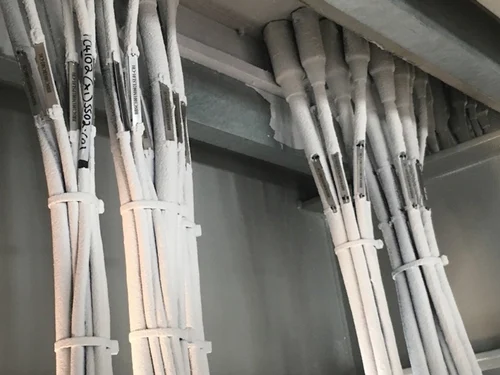Fire Protection HVAC Duct Sealing

HVAC Duct Sealing
The Importance of Fire Protection HVAC Duct Sealing for Firefighting
In modern buildings, the HVAC (Heating, Ventilation, and Air Conditioning) system plays a crucial role in ensuring air quality, comfort, and temperature control. However, when it comes to fire safety, HVAC systems can pose a significant risk. Ductwork within these systems often runs through various building sections, and in the event of a fire, they can act as channels for smoke, heat, and toxic gases to spread rapidly throughout the building. This is where fire protection HVAC duct sealing becomes critical.
In this article, we will explore the importance of fire protection HVAC duct sealing, how it works, and why it is essential for effective firefighting. Additionally, we will discuss how
Angel Safety Consultants can help protect your building from the risks posed by HVAC systems and provide key insights into the most searched keywords and trending hashtags related to fire protection HVAC duct sealing.
What is Fire Protection HVAC Duct Sealing?
Fire protection HVAC duct sealing refers to the installation of fire-resistant seals around ducts and air shafts within an HVAC system. These ducts are responsible for circulating air throughout the building, and they often pass through floors, walls, and ceilings. Without proper sealing, these ducts can become pathways for fire, smoke, and toxic gases, allowing them to spread quickly through multiple floors.
Fire protection sealing for HVAC ducts involves applying materials such as firestop sealants, fire-rated wraps, and other protective barriers around ducts and vents where they penetrate walls, ceilings, and floors. These seals prevent the spread of flames and smoke through the HVAC system, helping to limit the damage caused by a fire and increase the safety of the building’s occupants.
Why is Fire Protection HVAC Duct Sealing Important?
1. Prevents the Spread of Fire and Smoke :
HVAC systems can be a major source of fire and smoke spread in a building. If a fire starts in one area, the HVAC ducts can carry smoke and flames to other parts of the building in a matter of minutes. Fire protection HVAC duct sealing creates a barrier that prevents fire and smoke from passing through the ducts, containing the fire and reducing the potential for widespread damage.
2. Enhances Safety of Occupants :
The primary goal of any fire safety system is to protect human life. In a fire emergency, effective HVAC duct sealing ensures that the fire does not quickly spread throughout the building, allowing more time for evacuation. By preventing smoke and fire from reaching escape routes, fire protection sealing enhances the safety of building occupants.
3. Reduces the Risk of Toxic Gas Spread :
Fires release toxic gases, such as carbon monoxide and other harmful chemicals. When HVAC ducts are not properly sealed, these gases can easily travel through the ventilation system and affect large areas of the building. Fire protection HVAC duct sealing minimizes the spread of these dangerous gases, helping to protect the health of the building’s occupants during a fire.
4. Protects Building Infrastructure :
HVAC ducts often pass through critical parts of a building, including electrical rooms, data Centers, and storage areas. A fire in the ducts can cause extensive damage to these vital systems. By sealing HVAC ducts with fire-resistant materials, the risk of fire spreading to important infrastructure is greatly reduced, protecting both people and property.
5. Compliance with Fire Safety Regulations :
Most fire safety codes and regulations require buildings to have adequate firestopping measures, including for HVAC ducts. Fire protection sealing ensures that your building complies with local and national fire safety standards, helping you avoid potential penalties, insurance issues, and legal liabilities.
6. Helps in Containing Smoke During Firefighting :
Firefighters rely on clear pathways to combat fires effectively. When HVAC ducts are properly sealed, the spread of smoke and fire is contained, making it easier for firefighters to access the source of the fire and extinguish the flames. Effective sealing of HVAC ducts also helps preserve the visibility within the building, improving the efficiency of firefighting efforts.
7. Improves Fire-Resistance Ratings :
Fire protection HVAC duct sealing helps improve the fire-resistance rating of a building. When HVAC ducts are sealed, the overall fire resistance of the building structure is enhanced, preventing the rapid spread of flames and reducing the risk of a total loss.
8. Minimizes Property Loss :
The spread of fire and smoke through HVAC ducts can cause significant damage to both the building’s structure and its contents. Sealing the ducts helps to minimize the spread of fire and smoke, reducing the extent of property damage and preventing the need for extensive repairs.
9. Prevents System Contamination :
HVAC systems are designed to circulate clean air throughout the building. During a fire, HVAC ducts can carry contaminants such as soot and ash. Fire protection duct sealing prevents these harmful substances from circulating through the building, ensuring that the air quality remains as safe as possible for both building occupants and first responders.
10. Cost-Effective Fire Safety Solution :
Installing fire protection HVAC duct sealing is a relatively cost-effective fire safety measure compared to the potential financial losses from a fire. The cost of sealing HVAC ducts is small compared to the potential damage caused by an uncontrolled fire. By investing in fire protection sealing, building owners can prevent large-scale damage and minimize insurance claims.
How Fire Protection HVAC Duct Sealing Works
Fire protection HVAC duct sealing works by applying specially formulated firestop sealants or materials around the ducts at the points where they pass through fire-rated barriers such as floors, ceilings, and walls. These materials are designed to expand when exposed to high temperatures, filling gaps and preventing the passage of fire, smoke, and gases.
Here’s how the process typically works:
1. Assessment and Inspection :
A professional fire protection consultant, like Angel Safety Consultants, will assess your HVAC system to identify any openings or gaps around ducts that could allow fire, smoke, or gases to pass through.
2. Selection of Firestop Materials :
Based on the assessment, the right type of firestop materials will be selected. These may include fire-resistant sealants, fire-rated wraps, or firestop collars. The choice of material depends on factors such as the size of the ducts, the type of building, and the fire-resistance rating required.
3. Application of Fire Protection Sealants :
The selected firestop materials are applied around the ducts, ensuring that they form a tight seal. The sealant expands when exposed to heat, creating a barrier that prevents the spread of fire, smoke, and gases.
4. Regular Maintenance and Inspection :
After installation, it is essential to perform regular maintenance and inspections to ensure the fire protection HVAC duct sealing remains effective. Over time, the materials may degrade, and the seals may need to be replenished or repaired.
Benefits of Choosing Angel Safety Consultants for Fire Protection HVAC Duct Sealing
Angel Safety Consultants is a trusted provider of fire protection solutions, offering expertise in HVAC duct sealing. Our services include:
• Comprehensive fire safety assessments for HVAC systems
• Professional installation of fire protection HVAC duct sealing materials
• High-quality, fire-resistant materials from leading manufacturers
• Regular inspections and maintenance to ensure compliance with fire safety regulations
• Expert advice to help improve the fire safety of your building
By partnering with Angel Safety Consultants, you can be confident that your HVAC ducts are properly sealed, providing maximum protection against fire, smoke, and toxic gases.
In conclusion, fire protection HVAC duct sealing is an essential part of any fire safety plan. By preventing the spread of fire, smoke, and gases through HVAC ducts, this measure enhances the safety of building occupants, protects critical systems, and helps contain the fire during an emergency. Partner with Angel Safety Consultants to ensure that your HVAC system is properly sealed, providing the highest level of fire protection for your building.
